
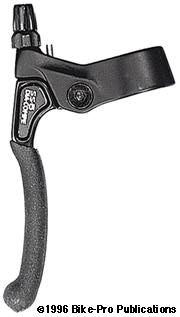
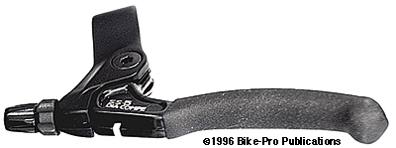
The SS-5 uses cold forged construction for its two primary pieces, the handle and the clamp assembly that holds it to the handlebar. The aluminum handle section is held to the clamp section with a steel bolt. The bolt has 5mm by .8mm threads that anchor into a steel nut with an 8mm outer hex on the lower side of the clamp. A nylon washer on the top and another on the bottom reduce the friction between the handle and clamp section as the lever is used. Dia-Compe uses a coiled steel return spring to push the lever closed after its released. The brake lever fastening bolt which holds the lever to the handlebar, has 6mm by 1mm threads with an 18mm length, a 4.5 gram weight and a 5mm hex fitting. The SS-5 uses a two piece cable barrel adjuster set. The adjuster is made of aluminum with a 3.5 gram weight and 7mm by 1mm threads. (It can be replaced by the Titanium type with our part # 06-91-CA-S, which weigh 2 grams more each, but some like Titanium). A Black composite plastic nut will hold the adjuster's position once set.
The handle has a 100mm length from the bolt holding it to the clamp section to its tip. The area for finger contact is 70mm long. The handle has a dense Black rubber sleeve to cushion the user's grip. Carbonworks makes a carbon fiber replacement that weighs just 17 grams for each of the two handles, in place of the 39 grams each for the originals. The SS-5 has a small steel set screw with a 2mm fitting near where the lever fastens to the clamp or bracket. This set screw sets how far the lever springs forward to close once it's been released. Tightening the screw shortens the distance the handle can travel so a small hand can use it comfortably. The SS-5 handle and clamping system are Black. The pair weight of the SS-5 levers complete is 173 grams. Made in Japan. $ Price in Catalog
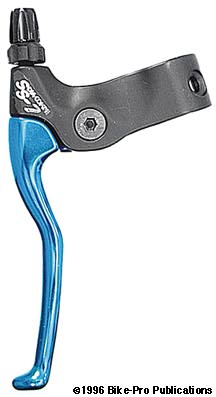
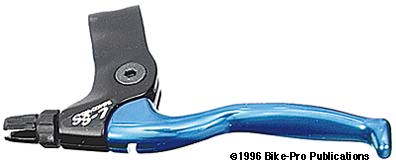
The handle section of the SS-7, because it is the most likely to be damaged in a fall, is made of cold forged aluminum. The handlebar clamp section is melt forged aluminum. The handle section is held to the clamp assembly using the same steel bolt found on the SS-5 levers. Made of steel, with a conical shape to recess the head, the bolt has a 4mm hex fitting and 5mm by .8mm threads. It anchors into an 8mm outer hex, cadmium steel nut on the bottom of the clamp section to hold both sections together. A nylon washer on the top and another on the bottom of the lever with the connecting bolt passing through them reduces friction as the lever is used. The return spring in the SS-7 is different from that in the SS-5. The SS-7 uses a small in diameter coiled spring like the type used to retract the ink cartridge in a ball point pen. (The one used in the SS-5 was coiled, but 13mm in diameter and coiled around the connecting bolt and washer assembly.) The SS-7 spring has a small nylon tip on it so the steel doesn't bind against the aluminum as it is worked.
The brake lever fastening bolt clamping the SS-7 to the handlebar is the same used in the SS-5. It has 6mm by 1mm threads, a 5mm hex fitting, a 18mm length and a 4.5 gram weight. The SS-7 uses the same cable barrel adjuster set found on the SS-5 levers. The handle has a 95mm length from the bolt holding it to the clamp section to it s tip. The area for finger contact is 65mm long. The SS-7 has a small steel set screw with a 2mm hex fitting that is used to adjust the "throw" (or how far the handle springs forward to close once it's been released) of the lever. Like the SS-5 levers, tightening this screw shortens the distance the handle can travel when released making it easier for a small hand to use. There are two recessed holes in the clamp section, that appear to be there only to reduce weight. The handle piece of the SS-7 can come in any of 4 colors, Blue, Black, Lavender, or Titanium Grey. The Clamp section is always Black. The pair weight of the SS-7 levers, complete is 179.5 grams. Made in Japan.
Color-B-BK-L-T $ Price in Catalog
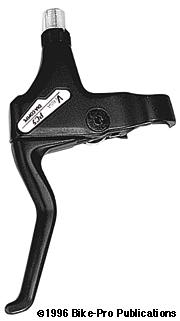
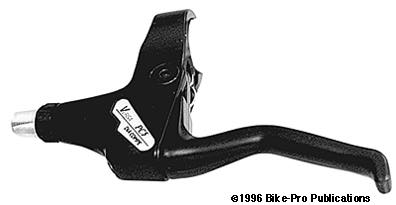
One of the problems the bike industry has had to come to terms with is its dependence on Japanese parts. And it's not the dependence on Japanese parts so much as the dependence on Japanese currency, the Yen. There are just a few left who remember the early 1980's when each delivery of Japanese goods came a lower and lower cost. At that time the US dollar was gaining influence and value worldwide. This lead to a high point in the exchange rate of 238 Yen to the US dollar In 1987, at President Reagan's behest James Baker met in Toronto with the other finance ministers of the Group of Seven nations or G7 as its known. The meeting was largely to establish how to weaken the dollar's value because the balance of trade deficit with other nations was wildly out of hand as Americans imported everything from cosmetics to drinking water. The result of the meeting began the steady erosion of the dollar's buying power.
Most people thought American exports would rise enough to equalize the trade balance, but a worldwide economic downturn was the actual result. There had been private hopes that countries like Japan would be unable to cope with the cheaper dollar, or that they would import more foreign goods. They didn't import appreciably more, and rather than have their slice of the world economic market change, the Japanese began to refine and streamline the way they manufactured, cutting costs and profits, while trying to hold onto market share. During this time there were initial investments in other parts of Asia, so the manufacturing, or sub-manufacturing could be done at lower cost. The result has been for the Japanese to move the core of their manufacturing to nearby, but low cost labor countries and the bike industry is no different. The Dollar now (June 4th, 1995) buys 83.61 yen which means that 1 dollar can buy, inflation adjusted, just 31% of what it was able to 7 years ago. Yoshigai, Dia-Compe USA's former parent company has moved a sizable part of their manufacturing out of Japan. The PC-5 lever set is made in their Taichung, Taiwan facility and 10 years ago this would have been unheard of.
The PC-5 is made with the two primary sections melt forged of aluminum. The pieces are linked in two ways. The first is the common way. A steel bolt with a conical head passes through both pieces holding them together, making a common pivot point. The bolt has 5mm by.8mm threads and anchors into a cadmium plated steel nut at the bottom of the clamp assembly. This nut has an 8mm outer hex exterior. The second way the two major assemblies are joined is through three steel linkages that are permanently riveted together forming a compound pulling linkage between the handle and housing. One end of the link set is riveted to the handle, the other to the clamp assembly. Though the steel pieces appear to add weight to the lever, the clamp assembly, though large in appearance is actually hollow. The steel linkage nestles right against the inner end of the cable barrel adjuster.
When the handle is pulled, the brake cable is drawn up more quickly than previous levers, when the handle had to pivot first at a distance, and draw up the brake cable afterward. This compound action the linage performs appears to be Dia Compe's response to Shimano's Servo-Wave though the two function a little differently. To reduce friction between the handle and clamp sections, there is a nylon washer above and below handle piece. The steel return spring is coiled with one end anchored in the handle and the other pushing against the inner clamp housing, like the SS-5, Logics and XC Pro levers. The pivot bolt holding the handle and clamp together passes through the nylon washers, spring and handle on its way to the nut at the lower side. The cable barrel adjusters are made of aluminum with the fixing nut made of Black plastic. The adjuster piece has 10mm by 1mm threads and weighs 3.5 grams. There are no Titanium replacements for it presently available.
The adjuster is always Silver, while the fixing nut is Black. A small steel screw on the clamp housing allows the "throw" of the lever to be adjusted. The area on the handle for the fingers to grip is 70mm long. The clamping system is always Black while the handle section can be either Black or Silver. The pair weight of the PC-5 levers is 228.5 grams. Made in Taiwan
Color - BK-S $ Price in Catalog
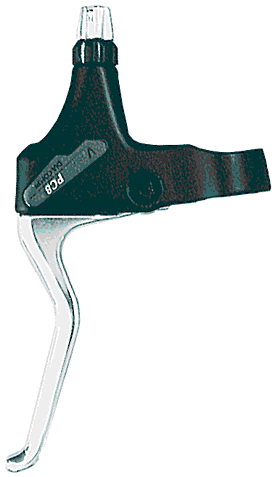
The Dia-Compe PC-8 levers are also made in Taiwan. The difference between the PC-5 and PC-8 is said to be that the PC-8 models have their handle and clamp housing made through a cold forging process.
The handle section of the lever is different, and is probably cold forged because of the smooth texture of its outer surface. The clamp assembly housing however appears to be the same one used in making the PC-5 and has the same casting marks that appeared on the back (bottom) of the PC-5 clamp housing which most die makers of experience would have omitted or changed if a separate die for forging had been made. We can tell that everything else about the PC-8 is the same as the PC-5. The same linkages joined the same away, the same bolts, positions, shapes, adjusters and finishes. The area on the handle for the fingers to grip is also 70mm long. The clamping system is always Black while the handle section can be either Black or Silver. The pair weight of the PC-8 levers is 228 grams. The PC-5 set appears to be the real value. Made in Taiwan
Color - BK-S $ Price in Catalog